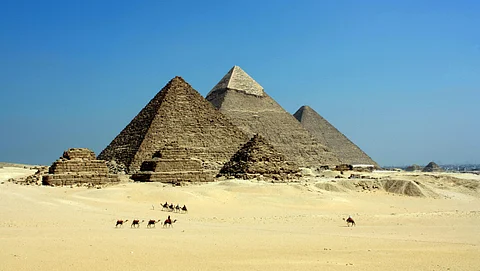
- Destinations
- Experiences
- Stay
- What's new
- Celebrating People
- Responsible Tourism
- CampaignsCampaigns
- SubscribeSubscribe
- Buy Now

Our knowledge of ancient civilisations have constantly been reshaped by archaeology. Towards this maxim, new archeological findings in Egypt and Israel have provided vital information on long-lost dynasties and historical mysteries. These discoveries not only broaden our understanding of the past, but also pose fresh investigations regarding the societies responsible for constructing these colossal constructions. From a strange pyramid in the Judean Desert to an ancient royal tomb in Abydos, Egypt, scholars are reassembling pieces of lost history that may change how we view these ancient societies.
At the Anubis Mountain necropolis in Abydos, Egypt, archaeologists from the University of Pennsylvania have discovered a 3,600-year-old royal tomb. The presence of the Abydos Dynasty, an elusive ruling dynasty thought to have ruled Upper Egypt between 1700 and 1600 B.C., is strongly supported by this important discovery.
The elaborate form of the tomb, which includes a limestone burial chamber encircled by tall mud-brick vaults, suggests that a formidable monarch from this little-known era is buried there. Archaeologists uncovered golden bands engraved with hieroglyphs at the entrance to the tomb, which could identify the individual and possibly connect them to King Senebkay, a previously identified Abydos Dynasty ruler. This discovery could help explain the dynasty's place in the larger Egyptian story filling up the gaps in Egypt's historical chronology.
About 11 km west of the Nile River in Upper Egypt is where you'll find Abydos. Sohag, a significant city with a domestic airport, is the closest. From Cairo, visitors can fly to Sohag, then take a private vehicle or cab to Abydos. As an alternative, visitors can arrange local transportation to the archaeological site from Sohag, which is connected to Cairo by trains and buses.
Researchers from the Israel Antiquities Authority (IAA) and the Ministry of Heritage discovered another ground-breaking discovery in the Judean Desert: a 2,200-year-old pyramid-shaped building. This monument, which was built from massive, carefully cut stones and is thought to have originated in the Hellenistic era, has produced a wealth of artefacts, including fabrics, bronze coins, wooden implements, and old manuscripts.
The structure's precise function is still unknown. According to scholars, it might have functioned as a ceremonial monument, a guard tower, or a tomb marker. Coins from Antiochus IV's and Ptolemaic monarchs' reigns suggest the site's importance during a tumultuous time in Judean history. The abundance of artefacts discovered makes this excavation one of the most fascinating and valuable discoveries in the area, offering new perspectives on the political and cultural forces of the era.
Southern Israel, close to the Dead Sea, is home to the Judean Desert. Travellers can fly into Tel Aviv's Ben Gurion International Airport and then drive or take a bus to Jerusalem to get to the area. Due to the difficult terrain, it is advised to use private vehicles or guided trips to reach archaeological sites in the desert.
These archaeological discoveries highlight the significance of further research while also shedding light on various facets of Judean and Egyptian history. The Abydos tomb provides concrete evidence of the Abydos Dynasty's power and rule, supporting its existence. In the meantime, the Judean Desert pyramid calls into question accepted historical accounts, leading academics to reconsider the Hellenistic era's architectural and cultural exchanges.
These findings might provide even more insight into the societies that constructed them when more excavations and investigations are carried out. We get closer to comprehending the intricacies of these ancient civilisations and their enduring legacies with each new artefact and inscription added to the jigsaw.
(With inputs from various sources.)
